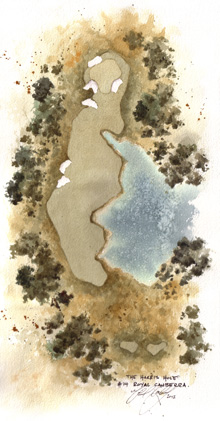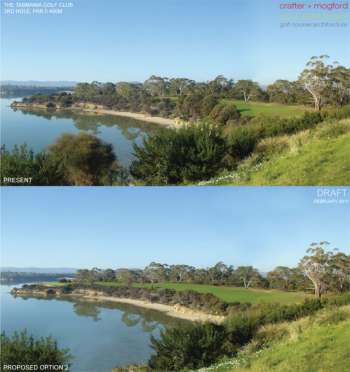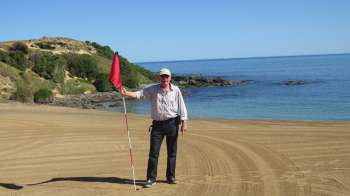In need of a Facelift - Aussie architects nominate 1 hole they want to redesign
Its been said countless times before that we golfers are all armchair architects and, as club boards and green committee’s know all too well, one of the problems with undertaking major redesign projects is the diversity of opinion from within a club on what needs to be fixed and how it should be done. Even the most critically acclaimed redesign work divides opinion, so it’s no wonder that some clubs are tentative about making changes to their golf holes.
The upside of course, is that improving your layout not only enhances the playing experience for the members but it can also help secure the financial future of your golf club. Bonnie Doon in Sydney, for instance, has signed up 150 new members since Ogilvy Clayton started their redevelopment work back in mid-2011. Stage one of that $3 Million project finally opened in May, and the feedback from members on the six new holes in play has been overwhelmingly positive. The decision makers at Bonnie Doon showed great leadership in undertaking such an ambitious redesign of their underperforming course. Due to the difficult economic climate at present, other clubs may not be in a position to be quite so bold but that doesn’t mean they shouldn’t be looking at ways to improve their layout.
In simplistic terms, great golf starts with great golf holes and the first step on the road to improving is to identify holes that can most easily be made better. With that in mind, we asked a number of Australian course architects to nominate the hole that they would most like to redesign. As Michael Clayton noted, ‘the two extremes of redesign are the good holes that can be made even better and the complete dogs that, as A.W Tillinghast so ably said, 'be made so they can hold their heads up in polite society'.’ There is a nice mix of both amongst the holes selected by our architects.
Michael Henderson – 14th Hole at Killara
Nothing causes more frustration to golf architecture enthusiasts than seeing good land go to waste. The potential for a great golf hole lies at the short par 4 14th at Killara Golf Club. Around 270m in length from the members’ tees, there is presently no option other than to hit straight between thick lines of trees and then advance to pitch up to the elevated green. In its current state the hole is uninspiring and completely devoid of any strategic values.
“Strategy is the soul of the game.” - George Thomas Jr.
The land the 14th occupies has similar qualities to the famous 10th at Royal Melbourne West and it is from this great golf hole that the architect should draw inspiration for change. Players hit over a sweeping valley and then up to the green positioned at the top of the next ridge.
The removal of trees in order to increase width and thus generate strategic values is critical to improving this hole.
“Trees should never be cut down if it is possible to save them; but he who insists on preserving a tree where it spoils a shot should have nothing to say about golf course architecture.” - George Thomas Jr.
The green should be remodelled so that it sits naturally along the slope on a left to right axis to oncoming play. A dramatic bunker carved into the front left side of the green would improve the visual beauty of the hole and enhance strategy. Widening of the hole through the removal of trees could allow bunkers to be placed on the higher right side of the fairway from where it is best to approach the green.
Golfers can attempt to go for the green from shorter tees, play out safely to the left and face a more difficult approach or; take on the bunkers on the right of the fairway and be rewarded with the best approach into the green. An ordinary hole is turned into a hole of strategic merit.
Michael Clayton – 14th Hole at Royal Canberra
The 14th hole at Royal Canberra is a good hole played over interesting land and with a green that rewards those who drive long and close to the fairway bunkers on the left.
The original designer, Commander John Harris, however drew a hole (one that was never built) that played from a tee far on the right and with a tee shot over the diagonal line of the edge of the lake (see right). There is a wide expanse of ground to the right running all the way to the lake (not currently any influence on the hole) and an opportunity to make that into fairway and build the amazing hole Harris drew.
The Harris hole would be one of the very best in the country.
Harley Kruse – 3rd Hole at St Michael’s
It shares the adjoining dunes of one of Australia’s greatest courses, NSW Golf Club, yet with a much lower profile St Michaels remains very comfortable in its own skin. It is a course of humble and modest beginnings on a spectacular site, albeit a little tight when compared with its neighbour.
St Michaels is a fun course and a dramatic place to play golf. It is a course that has resisted change but as golf course architect when I play St Michaels I can’t help but think of the wonderful possibilities to tweak the course here and there. I can think of quite a number of holes that could be vastly improved with relatively little effort and cost – to make the course more pleasurable and more strategically interesting to play.
I am a fan of uphill par 3’s such as Royal Melbourne West 7. St Michaels has one too - hole 3. It’s a wildly steep uphill shot to a small and blind green pitched atop a high dune. There are commanding views of the course and the Ocean from the green. It’s a very memorable hole but awkward. It’s not a lot of fun if you miss the putting surface as things fall away steeply front, back and to the right.
For me this hole presents a great opportunity. I would cut the green down some 2 metres or so to create more room for a slightly wider green and increased putting surface, but importantly there would now be room to ease the slopes around the green. The sandy cut material would be used to do this. The green itself could have two levels with a false front to help give the putting surface more visibility from the tees. The side slope on the left would run into the green a little and help feed shots onto the green. I would look at a modest size bunker on the right side to guard back right pin positions and possibly one just visible at the rear left to catch some long shots before they disappear.
The forward tees on this hole are dangerously close to the 2nd green and if room allowed I would move the tees further away and elevate them a metre or so. This would make things safer and easier for the women and shorter hitters.
This hole could be one of Australia’s greatest uphill Par 3’s.
Richard Chamberlain – 1st Hole at Coolangatta Tweed Heads (West Course)
The West Course at Coolangatta Tweed Heads is a beautiful layout, not overly long, but ideal for its member base. There are several instances, however, where the route to the green from a fairway bunker is hindered by trees. Strategically, a bunker should invoke a penalty for hitting your ball in a wrong spot but when the recovery shot is baulked by trees it acts as a “double penalty”, which I believe is particularly unfair. The 1st hole is not the worst example of this problem but a golf hole I believe can be significantly improved for very little outlay.
It’s certainly not a long Par 5 at 485m but one that could provide a lot more temptation to the golfer. The tee shot is faced with a group of bunkers on the left side between 205-245m. Behind these bunkers, and en route to the green are a few large Eucalypt trees. The last 100m of the hole features three fairway bunkers on the right side and then a green surface which is quite simple in its contouring, but on a slight angle from right to left. It is definitely easier to approach from the right side.
Shorter hitters must keep their tee shots to the extreme right of the fairway as these large Eucalypts block the second shot from the entire left hand side. Players unfortunate enough to hit one of the fairway bunkers must not only recover from the sand but also avoid the large trees. Often a lofted iron hit to the right is the only option available, which is extremely penal.
My solution to this hole simply involves the removal of two or three trees and a minor adjustment to one of the fairway bunkers nearer to the green. By removing the large Eucalypts that hinder the route, longer hitters may be tempted to fly the last fairway bunker on the left and then attack the green in two. Even players that hit in the 190-240m range would be tempted to hit closer to the bunkers to establish a better lay-up position. At present the bunkers work in reverse with most players hitting as far away from them as possible. The removal of the trees will effectively widen the landing area, which I believe is particularly helpful being the opening tee shot of the round.
As a result of more players being tempted to hit the green in two there should be a slight modification made to the bunker on the right, 40m short of the green. This will put more emphasis on the accuracy and distance of the long approach shot. The green surface and its surrounds need not be touched at all. Whilst hopefully more players will be attacking this green in two, some may succeed and other may not. It will not create an easier hole but a far more tempting one. Unfortunately for me, not a result that will put many dollars in the golf architects pocket but an inexpensive solution for the club to make the golf hole significantly more exciting.
Michael Coate – 18th Hole at Lake Karrinyup
Lake Karrinyup was laid out in 1928 by Alex Russell and because earthmoving was limited in those times and the site is quite hilly, there are a number of holes which play up and over steep hills.
By the time one reaches the 18th (373m par 4), presuming playing on foot and not in a cart, the hilly layout will likely have taken its toll and the prospect of climbing the 18th hill, 180m at a grade of 1 in 9, is a grim one.
From a playing point of view, the hill penalises the shorter hitters whose drives may not reach the crest of the hill and will gain little or no run. In contrast, the long hitter will easily carry the hill and may gain considerable run.
Finally, there is an element of danger when long hitters load up from the tee, unaware that players ahead have not cleared their distance of drive.
Some years ago I carried out a contour analysis to lower the hill. This analysis showed that it is possible, by cutting up to 3.8m in depth, to reduce the grade of the hill to 1 in 12, making the climb considerably easier, the hole more equitable and the danger reduced.
Drive bunkering could be created on the left of the dogleg and a physically easier and strategically more interesting hole would result.
Neil Crafter – 3rd Hole at Tasmania GC
Tasmania Golf Club's 3rd hole is one of the most recognized holes in all of Tasmania since its creation back in 1971 by architect Al Howard, who incidentally just celebrated his 99th birthday. The hole is a dogleg par five that curves to the left along the coast of Barilla Bay, and when first laid out by Al the vegetation along the coastal edge was less thick than it is today. Played from elevated tees, the views are spectacular, but once on the fairway the golfer loses all sense of being adjacent to the water due to the wall of vegetation, and similarly, the green cannot be seen from the tee.
It is this sense of isolation from the water that our suggested redesign primarily seeks to address, and the removal of a number of bushes and casuarina trees between the fairway and the water will considerably open up these views. The green is similarly isolated from the water and we would propose to move the green off to the left to bring the water into play for approach shots, while removing the bushes behind the green to allow long views to the bay beyond.
These relatively simple redesign measures will help to restore Al's vision for this hole and create more stimulating and exhilarating golf in the process. A nice birthday present for you Al.
What do you think?
Whether it’s changing a tee or completely ripping up a fairway, all golfers have stood on a green and been convinced that they know how to improve the hole they just played. We would be happy to hear readers thoughts on this subject, so feel free to send in your feedback on the poor holes at your club or perhaps answer the question, ‘if you were given your choice of any hole in Australia to redesign, which one would it be and how would you fix it?
Darius Oliver, Architecture Editor
Back to NewsMore News
Who Really Designed Cape Wickham Links?
AGD ranks Cape Wickham #1 in Australia & interviews Duncan Andrews to get full story on course design
Landmark professional golf tournament coming to Auckland
Pro golf will make a major return to NZ's largest city next March with event hosted by Royal Auckland & Grange
Grace Kim confirmed for 2026 women's Australian Open
Australian star will headline the Women’s Open when it returns to Kooyonga Golf Course in March
AGF releases 2024/25 Impact Report, highlighting life-changing opportunities for young Australians
The Australian Golf Foundation Report reveals a year of progress in making golf more accessible, inclusive, and life-changing for young people




